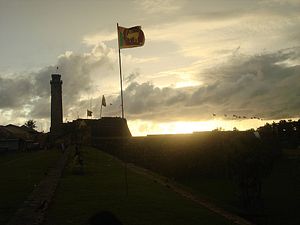What the past (and future) of the Tamil version of the national anthem tells us about minority rights in Sri Lanka.

Credit: Wikimedia Commons/ Gethmaperera
But against the backdrop of a surge in Sinhalese-Buddhist supremacy, media reports on the imminent abolition of the Tamil national anthem have surfaced.
The national anthem of Sri Lanka was composed by Ananda Samarakoon (1911-1962), a composer and music teacher. In post-independent Sri Lanka, the Tamil national anthem was mostly sung in the Tamil-speaking Northern and Eastern provinces. With the rise of the Liberation Tigers of Tamil Eelam (LTTE) in the late 1980s, the Eelam song gained momentum in Tamil-speaking regions while the Tamil national anthem was rarely sung in Sinhalese-majority areas. The 1978 Sri Lankan Constitution provided exclusive sanction to the Sinhala national anthem but the Tamil translation was also given constitutional recognition by way of the third schedule to the seventh clause. Nonetheless, the 13th amendment to the constitution declared Sinhala and Tamil as both official and national languages, whereas English was declared the link language. Such ad hoc language policies exacerbated the ethnic divisions among the Sinhalese and Tamils amid escalating violence between the LTTE and the security forces.
Even in post-conflict afterlife, the Tamil national anthem was not sung in public domains. In 2010, during the Mahinda Rajapaksa administration, the Tamil national anthem gained attention. Wimal Weerawansa, the minister of housing and construction, branded the practice of singing the Tamil national anthem a joke, much to the dismay of the Tamil community. But in 2016, the new Sirisena-Wickremesinghe government issued a circular stating that there is no ban on singing the national anthem in Tamil. During the 2016 Independence Day commemoration, the Tamil national anthem was sung for the first time since the 1949 Independence Day celebrations, despite public outcry from the Sinhalese community.
At present, Sri Lanka stands at a crossroads as the newly-elected President Gotabaya Rajapaksa is yet to appoint a Cabinet of Ministers. However, emerging anti-minority rhetoric could pose a serious challenge to achieving long-term peace in the Sri Lankan context. The assertion of Sinhalese-Buddhist identity on the minority ethnic groups may result in deepening enmity between the diverse ethnic and religious groups that make up Sri Lanka. Respecting the linguistic rights of all communities is one of the ways to avoid the past mistake of language discrimination. In this light, the Tamil national anthem is an important litmus test: If the Tamil version of the national anthem is ever banned, it is likely to set a dangerous precedent to the rights of minorities. In that case, it would be ironic indeed for the new government to urge minorities to rally behind their cause.
Dishani Senaratne is an independent scholar and published writer, who previously taught at the Sabaragamuwa University of Sri Lanka. Writing Doves is her latest non-profit initiative. Funded by the US Embassy to Sri Lanka and administered by Sarvodaya Sri Lanka, the project seeks to enhance intercultural understanding among young learners in Sri Lanka through trilingual narratives.